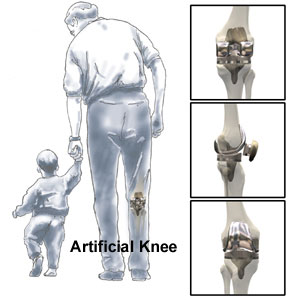
 |
| Osteoarthritis Written by DynoMed.com, Indianapolis, IN Osteoarthritis is the most common form of arthritis affecting one out of eight people between the ages of 18 and 79. According to the Arthritis Foundation, approximately 16 million Americans suffer from osteoarthritis, three times as many women than men. As we grow older, parts of our body wear out. This is true of cartilage, the shock absorber and sliding surface that covers the ends of bones. By the time you are 50 years old, there is a 90 percent chance that you will have some visible change in your cartilage. Osteoarthritis develops when cartilage wears out and bone rubs against bone. Cartilage contains fluid and elastic tissue, and reduces friction as the joint moves. Most often the weight-bearing joints, such as the hips, knees and spine, are affected by osteoarthritis.
|
|
|
Causes of Osteoarthritis Osteoarthritis used to be seen only as an older person’s disease. Now, because of the modern stresses in our lives, people of all ages suffer from the aches and pains associated with osteoarthritis. General wear and tear on the joints can cause osteoarthritis. However, playing sports such as jogging, tennis and skiing are also potential instigators of the disease. If your occupation entails heavy lifting or excessive use of your hands, you may be at a greater risk of developing osteoarthritis. There is no known cause of osteoarthritis. A specific joint injury or other joint disease like rheumatoid arthritis may cause osteoarthritis. Gout and congenital defects to the joint are secondary causes of osteoarthritis. Hypermobiles, or people that are extremely flexible, are also more prone to the disease. Some recent studies have pointed to genetics as a possible cause. It could be possible that some cartilage is more likely to degenerate than others. Chemical reactions in your body could also lead to the breakdown of cartilage, various experts believe (The Arthritis Bible, Healing Arts Press, 1999). At this time researchers are trying to develop a test that will detect the breakdown of cartilage. As with most types of arthritis, being overweight also plays a role because of the added pressure on the body. Symptoms of Osteoarthritis If you suspect you have osteoarthritis, visit your doctor. He or she will perform a series of tests to determine if you have arthritis and what type. X-rays may be ordered to see if the bone and cartilage have been damaged. Blood tests may be ordered to rule out other types of disease. The outlook for the disease depends mainly on which joints are affected and how serious it is. There are many forms of treatment and, by starting early, you can start to live your life more fully. Treatment of Osteoarthritis Exercise, weight loss, rest and proper nutrition are very helpful in treating this disease. Through exercise, you can regain strength and manage your body weight. Proper nutrition and rest will make sure you feel your best. It is important to discuss any exercise program with your doctor or physical therapist before starting one. You should also talk with your doctor before taking alternative medicines, dietary supplements, and herbal medicines to treat your arthritis. There are many assistive devices
designed to make your life easier. Opening car doors and cans and bottles
is made easier through new inventions. The old-fashioned cane can help
you continue to walk and to get your exercise. Some people find that using
heat or cold applications or paraffin baths help relieve pain and regain
joint mobility. There are several types of surgical treatments available. Surgery may be an option if you are suffering from osteoarthritis of the hip, knee, back, shoulder, hand or foot. Joint replacement techniques have advanced in the last 25 years making this surgery more common. Your doctor will help you make this serious decision based on the level of your pain, job and age. |
|
 |
|
| Learning that you have osteoarthritis, does not have to mean an end to your active lifestyle. Your physician can help you find the most effective treatment for managing your osteoarthritis and controlling your arthritis pain. | |